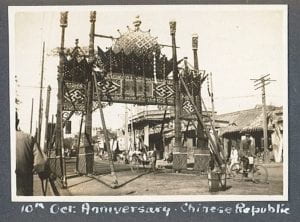Anniversary of the Chinese Republic
Katherine Molyneux
It is a photograph of an dusty street in an unnamed city. There are bicycles and a blurry power line. In the background is a low-rise building that might be a market. In the foreground – dominating the scene – is a ceremonial gate, which appears to be made of wood. It is topped by a large dome.

Underneath this particular photograph someone – we assume Dr Porter – has written “10 Oct: Anniversary – Chinese Republic.” This is almost certainly a reference to the Wuchang Uprising that commenced on October 10 1911 – the start of a chain of events that led to the final collapse of China’s last dynasty and the formation of the Republic of China (RoC). During China’s Republican era (1912-1949), October 10 was celebrated as China’s national day.
What can this photograph tell us? Out of context, it might simply being an isolated data point: an unnamed Chinese city in an unidentified year. Any additional information would be guess-work hazarded on the basis of the photo-stock and the subject-matter. The presence of power-lines and the absence of cars might allow an informed observer to narrow the probably era down to a couple of decades – but China is vast and economic development has always been geographically uneven. The artistic style of the gate might offer other clues.
But for an historian, layers of meaning are added to the photograph by its location – in the University of Melbourne archive, amongst the personal effects of Dr Porter, in this album, with this notation. As with many archival photographs, it tells us as much about the historical context of the author as it does about the ostensible subject of the photograph.
Firstly, we know from Dr Porter’s biography that this photograph was probably taken on her travels with her father during the 1920s. Both Porter and her father were deeply religious, and active in fundraising for missionary activities across South and South-East Asia. One of the two leather-bound photo albums in Dr Porter’s archives is entirely dedicated to recording her visits to missions across Asia: it is carefully annotated in a way that would have made it an effective tool for fundraising in Melbourne.
As such, Dr Porter’s photographs from Asia can be regarded as an example of two overlapping genres of early twentieth century photography: touristic photographs of ‘the orient’, and photographs of missionary activities in ‘exotic’ locations. Recent generations of scholars have made significant contributions in illustrating how Western photographs were influenced by the expectations of their intended audience ‘back home’.1
However, there is an additional layer to this particular photograph, as it was not found in Dr Porter’s missionary album, but in the archive’s second album. This second album appears to be a much more personal document: there are many photographs of family and friends; and several pages are dedicated to snapshots of a much-loved dog. The travel photographs that are included tend to be snapshots of street-scenes or acquaintances. The page with our photograph also includes Shanghai street scenes and images of a man in posing next to an anthill and fan palm in Sri Lanka.
In this context, our photograph of a ceremonial gate seems out of place. Dr Porter has not recorded the location, and the ink colour suggests the photograph was printed separately from the others on the page (though the annotations seem to have been made at the same time). Is she indicating that the photograph was taken on October 10 – or that she was writing her annotations on October 10?
Perhaps neither – as this is a personal album, this combination of image and date may have had some private resonance for her. But it is worth noting that she was a self-aware private historian – we can see from her archive that she was active in curating her father’s legacy, and left the archive a few pages of biography in addition to the extensive collection of correspondence.
A final layer of complexity: the gate in the photograph is far from typically Chinese in style – the dome at the top is highly unusual, and seems to suggest the influence of islamic architecture. Based on a preliminary search, I have been unable to discover any other photographs of this gate, or any other gates in this unusual style. This raising some tantalising questions for further research: has Dr Porter simply matched a ‘oriental’ image with a fact about Chinese history? Or did she know something about this gate – was it a temporary construction built to mark the Chinese national day? Perhaps the photograph wasn’t taken in China at all – it might be the entrance to the Chinese district in a foreign city.
Citations
1 See for example Kathryn T Long “”Cameras ‘Never Lie'”: The Role of Photography in Telling the Story of American Evangelical Missions.” Church History 72:4 (2003): 820-51. http://www.jstor.org/ stable/4146374; Anne Maxwell, “Framing the Non-West: New approaches to the history of photography,” Journal of Colonialism and Colonial History, 16:1 (Spring 2015) Access via Project Muse.
Leave a Reply